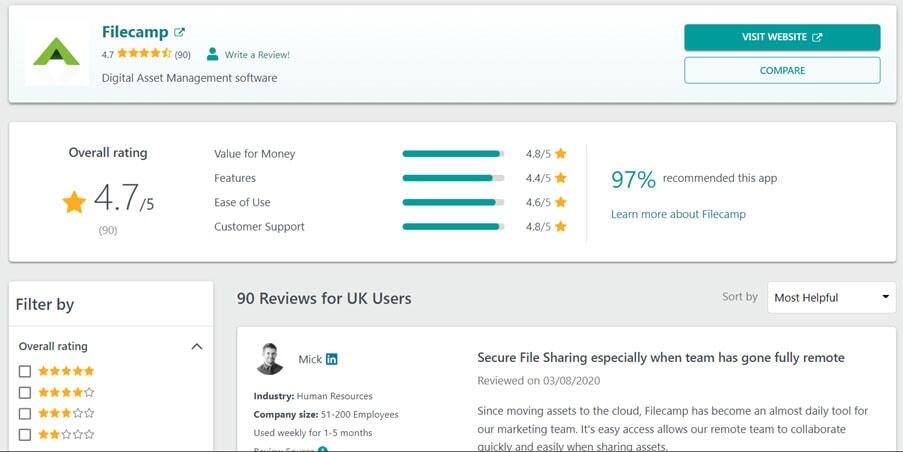content marketing
How effective are reviews and testimonials in content marketing?
Building trust and credibility are essential parts of an inbound marketing strategy to help resolve your potential customer’s pain points and lead them along the buyer’s journey. Without trust and credibility, it’s unlikely that many will convert to customers.
That’s why it’s important to utilise a range of inbound and content marketing tactics to guide your potential customers along the buyer’s journey. Most importantly, however, you need to showcase how your product or service will benefit your customer. That’s where reviews and testimonials come in.
What are reviews?
A review is a customer’s opinion on the experience they received from using a product or service. Most commonly, reviews are found on e-commerce sites, including Amazon. However, reviews can also be found on other platforms, such as Google and business directories.
Reviews are mostly witnessed in a business-to-consumer (B2C) situation. Using reviews in the buyer’s journey allows potential customers to determine how effective a product/service is at addressing their pain points. Essentially, it allows a customer to see if your product/service will be a worthwhile investment.
Anyone can leave a review, leaving them open to both positive and negative viewpoints. Most reviews follow a 5-point system, usually depicted with stars. The higher the rating, the more positive the experience a customer received (and vice versa).
As reviews are left by customers of a product or service, and not coming from the company directly, people perceive them to be a lot more trustworthy and reliable. It’s estimated that 69% of customers trust reviews as much as a personal recommendation.
Responding to reviews
While reviews are important, whether you respond to reviews and how you respond also makes a big difference. Taking the time to respond to reviews shows to both your potential customers and current customers that you care about them and value their input.
But how you respond to reviews is also important. Bad responses won’t help you to develop a positive experience. If you want to be developing positive relationships with your customers, consider these tips for responding to reviews (both positive and negative):
- Respond as quickly as possible (the sooner the better)
- Begin by thanking the customer for their review and custom
- Personally address the customer with their name
- Don’t waffle and keep the response as short as possible
- Apologise and sympathise if the customer experienced bad service / a mistake was made
- Take responsibility, address the problem, and make things right.
- Where privacy may be a concern, or if there’s an issue, take the conversation away from reviews to a direct form of communication (such as chat, email, or phone).
If you’ve received a negative review, never close the door on a customer. You should always give them a second chance to show you learnt from your mistake. A perfect opportunity for turning a wrong into a right.
With these tips in mind for responding to reviews, you can help retain your customers, drive stronger brand advocates (important for the delight stage of the inbound marketing process), and take negative feedback as room for growth. Implementing your targeted keywords into a review (where relevant) can also aid your SEO efforts too!
What are testimonials?
Testimonials are different from reviews. While reviews and testimonials are similar, testimonials can give much greater insight. Unlike reviews which are usually short, a testimonial provides a much more in-depth story about the customer’s experience.
The major difference between testimonials and reviews is that a review is often managed and hosted by a third-party source, such as reviews on GetApp for Filecamp:
A testimonial is not and is instead collected and managed by the business directly.
Despite the fact a business has much more control over testimonials than reviews, it doesn’t affect the extent potential buyers trust them. As testimonials are given and managed directly by the business,
Testimonials can also be text or video-based, which is another major difference between reviews and testimonials. When an estimated 95% will remember a message from a video over just 10% from reading text shows how impactful a video testimonial can be over a written one.
A testimonial’s strength lies in its length. While reviews are much more influential in greater quantities, a testimonial is more advantageous due to having greater detail and length. But don’t stretch to more than 3 paragraphs.
Testimonials provide a great resource for incorporating across your website and other content marketing materials. This helps build an emotional connection with your potential buyers and build the trust and credibility that’s vital for that all-important conversion.
It may be worth pointing out, however, that testimonials and endorsements are also not the same things. An endorsement is a public recommendation given by an influencer, usually with a strong social media following. A testimonial is given by a customer or client who, while unknown to the reader, has personal experience from using a product/service.
Using reviews and testimonials in inbound marketing
Reviews and testimonials play a significant role in the decision stage of the buyer’s journey. At the final stage of the buyer’s journey, the buyer has a solid idea of the solutions available to them. All that remains is to decide on which solution to go for.
Continuing to provide meaningful and relevant content to buyers throughout the buyer’s journey (which is essential to inbound marketing) will help lead a customer to choose you over the alternatives.
At the decision stage, a buyer will have all the information they need, and they will be looking to compare the available options. While you can offer other methods (such as demos, pricing guides, or competitor comparisons), reviews and testimonials are a key component of the decision stage.
Once a lead has converted, you can look to build your reviews and testimonials to help aid the decisions of future buyers. Continuing to delight a customer after purchasing will lead to positive word-of-mouth.
Positive word-of-mouth (WOM), whether it comes from reviews or not, is one of the strongest influential information sources for shaping attitudes towards a brand or product. When positive WOM impressions can drive a 5x increase in sales compared to paid impressions this shows just how impactful WOM can be.
Here are some tips for how you can get quality reviews and testimonials:
- Ask your customers or clients. An average of 70% of customers who are asked to leave a review will do so.
- Use surveys and other marketing research methods to gauge customer experiences
- Use what people have already said (but ask permission first)
- Exchange testimonials
- Make use of Google reviews and business directory reviews
- Offer an incentive (check the review site’s conditions). Also never pay for reviews or testimonials.
- Use Google Alerts and a social monitoring tool to track mentions and reviews of your brand on third-party sites.
The importance of reviews and testimonials
We’ve already briefly touched upon how reviews and testimonials are trusted as much as personal recommendations by nearly three-quarters of customers. 93% will look at reviews before making a purchase decision, highlighting just how significant they are.
But there are other reasons reviews and testimonials are so important.
✓ Help build trust and credibility
Reviews and testimonials are incredibly important for building trust and credibility. It’s considered that a brand with reviews is 63% more likely to be trusted by a customer than a brand without.
The main reason why reviews are considered so effective at building trust and credibility is that they come from a customer, not the business. People are much more likely to trust the recommendations from other customers.
Your potential buyers will look at reviews to get a first-hand insight into the views and opinions of others about using a product/service. It’s a proven fact that buyers trust the views and opinions of others.
Using reviews and word-of-mouth is also a great way to target different generations, particularly millennials.
✓ A first-hand account of solving a problem
This may seem obvious, but a review or testimonial gives your potential customers a first-hand account of how your product or service solved a problem.
Typically, testimonials provide a story. They’ll start with the problem that the customer was facing. The testimonial will then go on to detail how using X product/service solved their problem, and the results or outcome of using X product/service.
A testimonial is a story with a situation or person the potential buyer can relate to. Your potential buyers can relate to the testimonial and connect with the problem as they are experiencing it themselves. Adding the human angle helps increase the effectiveness of a testimonial.
✓ Social proof
Reviews and testimonials are great examples of social proof marketing. Social proof is where someone will copy or mimic the behaviour or actions of others. It’s based on the idea of normative social influence.
People are influenced by the actions of others, and many will follow the actions or behaviours of others to fit in. Reviews and testimonials are a top form of social proof that can influence your potential buyer’s decisions.
Even a mention of some of the brands your business has worked with, or the number of customers is a way to implement social proof on your site. Here’s an example from the Filecamp homepage:
Higher lead conversion rate
Using reviews and testimonials can help boost your conversion rate. Given how much of an impact that reviews and testimonials can have on potential buyers purchasing decisions, it should come as no surprise that your lead conversion rate will improve.
Incorporating reviews and testimonials into your content marketing will be a sure way of leading 58% more of your customers to convert. Also, a stronger portfolio of reviews will help to drive a 4.6% increase in your conversion rate.
Reviews and testimonials in your content marketing
If you’re a business with good reviews and testimonials, you’ll undoubtedly want to use them in your content marketing to help drive leads towards converting. Here’s how you can make good use of these reviews and testimonials in your content marketing:
Incorporate reviews and testimonials into your website
What better place to include reviews and testimonials than where a potential customer is likely to convert on your website?
There are lots of places you can consider incorporating reviews and testimonials on your website:
- The homepage
- On product or service listing pages
- Landing pages
- Next to call-to-actions
- A dedicated testimonials page, including the customer’s name, company, and profile
Here’s an example of the testimonials page for Filecamp:
Content creation
The content you create, whether it’s a blog post or a video, is another great place to consider adding reviews and testimonials. Anyone who views your content is a potential prospect, so why not try to influence their purchasing decision?
Whether you look at adding brief testimonials or extracts inside your latest blog post, or showcasing your high review rating in a video posted to social media, these are great ways to grab the attention and interest of potential customers.
Just make sure you don’t make the reviews or testimonials included in your content creation intrusive so that it ruins the flow of your content.
Case studies
Many businesses will create case studies to showcase success for a given situation. Whether it’s work you carried out for a client or a success story for something you or your customers have achieved, case studies are another ideal place for incorporating reviews and testimonials.
Adding testimonials and reviews in the right place can help to emphasise and back up the claims made in your case study. That way, a customer is much more likely to believe what you have to say. While case studies are effective at the decision stage of the buyer’s journey, the combination of case studies, reviews, and testimonials is even better!
Product or service pages
If you’ve seen the reviews on Amazon or other e-commerce sites, you’ll know about the inclusion on your product or service pages. These pages are where a customer is going to buy a product, so it makes sense to include reviews and testimonials right where a customer will take action.
Including reviews and testimonials next to a call-to-action is another way to help drive those actions and encourage a customer to click. Including the reviews and testimonials as close as possible to a call-to-action will increase the likelihood of a user acting on it, such as on the Filecamp product page for low-cost DAM solutions:

Aaron Middleton
Share this Post


